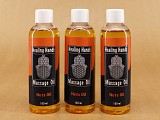30 Ml from Brazil (SKU 4444)
Urucum Coconut Cream is a natural blend of raw Balinese Coconut oil and Urucum (Annatto) extract from the Achiote tree. Traditionally used as a body paint and protective dye in the Amazon, Urucum carries a warm solar quality, here balanced by the soothing, nourishing nature of Coconut. The cream absorbs quickly, leaving skin moisturized and with a gentle golden-orange glow. It can be applied to the face, body, or hair, where it adds shine and can soften the appearance of grey. Each batch varies naturally; in cooler temperatures it may solidify—simply warm the bottle in water and shake to blend before use. More information below in the description.
Packed in 30 ml glass jars.
Urucum Coconut Cream – Nourishment with a Solar Glow
Function and Composition
Urucum Coconut Cream is prepared from raw, cold-pressed Coconut oil from Bali, blended with the natural pigment-rich extract of Urucum, also known as Annatto (Bixa orellana). The result is a smooth, deeply nourishing cream that absorbs quickly into the skin without leaving a fatty residue. Applied in small amounts, it moisturizes and protects, leaving the skin supple and carrying a slight, and warm golden-orange hue. It can be used for face massage, as a natural bronzing balm, for body care on sun-exposed areas, and even in the hair, where it lends shine and can gently mask greys.
Energetic and Ceremonial Qualities
In traditional Amazonian practice, Urucum is seen as a solar plant — bright, protective, and life-affirming. Combined with the cooling, nourishing quality of Coconut, this cream balances fire and water: warmth with calm, protection with soothing care. It may be applied before sun exposure as a light natural shield or as part of a daily anointment practice to bring glow and radiance. Beyond its practical role, the application carries a sense of ceremony — of painting the body with the colors of the forest.
Cultural and Botanical Background of Urucum
Urucum comes from the seeds of the Achiote tree (Bixa orellana), a shrub native to tropical regions of the Americas. Its seeds, encased in scarlet pods, have long been used by Indigenous peoples of the Amazon as body paint, lipstick, and ceremonial coloring. Known as the “Lipstick Tree,” Achiote holds deep cultural symbolism as both protector and adornment. Its bright red pigment, Annatto, is now widely used as a natural colorant in foods and artisanal preparations, but its first and most enduring role was as a sacred paint for body and spirit. Traditionally, Urucum paste was also applied as a deterrent against insects and snakes, enhancing its protective reputation.
Ingredient Spotlight: Coconut Oil
Coconut oil, derived from the fruit of the Coconut palm, is prized for its softening, nourishing, and preserving qualities. At cooler temperatures, it solidifies into a white balm; in warmth, it becomes a clear, easily absorbed oil. In this preparation, Coconut acts as the carrier for Urucum’s pigments and properties, softening their intensity while adding its own stabilizing and moisturizing effect. Together, they form a preparation that is at once practical and ceremonial.
Natural Variation and Care Notes
A very small amount suffices, as the cream spreads and absorbs readily. Because this product is made with raw, artisanal Coconut oil and natural Urucum extract, its texture may shift slightly with temperature. At warm temperatures it liquefies; in cooler environments it solidifies. Each batch carries subtle variations of color and aroma, reflecting the natural character of its ingredients. When the cream is partly solidified, it is best to gently warm the bottle in a bowl of warm water. Once softened, shake well to ensure that the coconut oil and Urucum extract are evenly blended before use.
This natural product is offered for its ethnographic and historical value and is delivered with no expressed or implied fitness for a specific purpose. It is simply a raw botanical specimen, or a scientific sample. The information provided is purely meant for historical, scientific and educational purposes and should never be interpreted as a recommendation for a specific use. The use and application of our product is at the customer's decision, responsibility and risk.
Read our Terms & Conditions for more details.

